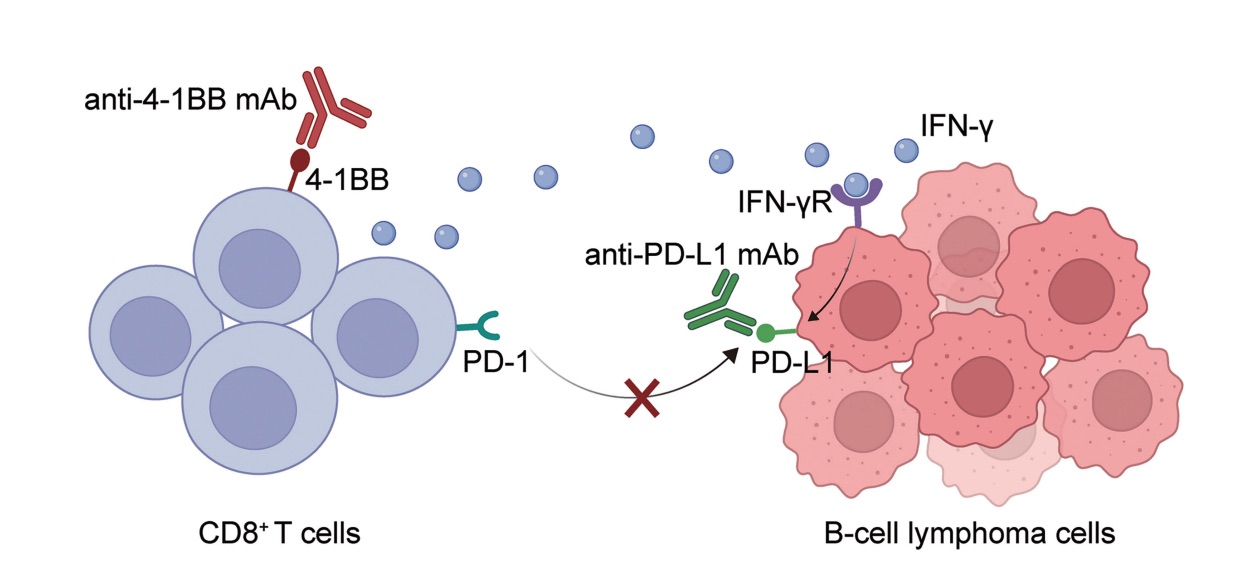Hi-Affi™ hPD-1/hPD-L1/h4-1BB Triple Humanized Mouse Model
Apart from PD-1, PD-L1, and CTLA-4, several costimulatory receptors responsible for T activation have been demonstrated, such as 4-1BB. Based on the enhanced immunity of the anti-PD-1 antibody and anti-PD-L1 antibody, adding the anti-4-1BB agonist antibody can further enhance the body's immunity against tumors, which is a promising option for clinical treatment. Creative Biolabs has successfully established an optimized Hi-Affi™ “humanized” animal platform to offer specialty manipulated hPD-1/hPD-L1/h4-1BB triple humanized mice for our clients all over the world.
hPD-1/hPD-L1/h4-1BB Molecule
Human programmed cell death protein-1 (hPD-1) is a type I transmembrane glycoprotein and belongs to the immunoglobulin superfamily. Its remarkable feature is that the cytoplasmic region contains N-terminal and C-terminal tyrosine residues. The former is involved in the formation of an immunoreceptor tyrosine inhibitory motif (ITIM), and the latter is involved in the formation of an immunoreceptor tyrosine conversion motif (ITSM). Among them, ITSM plays a key role in the negative regulation of hPD-1. hPD-1 and its ligand human programmed cell death ligand-1 (hPD-L1) forms a signaling pathway. Under normal circumstances, hPD-L1 has constitutively low expression levels in antigen-presenting cells (APCs), as well as non-hematopoietic cells such as vascular endothelial cells, islet cells, and immune exemptions (such as placenta, testis, and eyes). However, high-level expression of hPD-L1 can be induced in tumor cells.
Human 4-1BB (h4-1BB) is a member of the superfamily of surface glycoproteins and tumor necrosis factor receptor (TNFR). It was initially believed that h4-1BB expression was limited to activated T cells, but later studies found that h4-1BB is widely expressed throughout the hematopoietic and non-hematopoietic cell compartments, such as dendritic cells (DCs), activated monocytes, natural killer cells (NKs), neutrophils, eosinophils, and mast cells. On NKs, h4-1BB signaling can increase antibody-dependent cell-mediated cytotoxicity (ADCC).
 Fig. 1 A graphical description of how PD-L1 blockade and 4-1BB agonism elicited enhanced antitumor effect in BCL.1
Fig. 1 A graphical description of how PD-L1 blockade and 4-1BB agonism elicited enhanced antitumor effect in BCL.1
hPD-1/hPD-L1/h4-1BB Signal Pathway
The complete activation of T cells relies on the regulation of the "dual signal" system. One of the signals comes from the costimulatory molecules, that is, the interaction between the costimulatory molecules expressed by APCs and the corresponding receptors or ligands on the surface of T cells. CD28 and B7 are important positive costimulatory molecules. Besides, to ensure that T cells are not overstimulated, there are negative costimulatory molecules that regulate T cells. After the tumor cells invade, they will use these inhibitory molecules such as hPD-1 and hPD-L1 to suppress the activation of T cells and escape the encirclement and suppression of the immune system.
In the presence of the T cell receptor (TCR) signal, the h4-1BB co-stimulation signal can cooperate with the CD28 co-stimulation signal to maintain the activation state of T cells and inhibit the occurrence of activation-induced apoptosis (AICD). The CD28 costimulatory signal mainly plays a role in the early stage of T cell activation, promoting T cell proliferation, and maintaining its short-term survival. The h4-1BB costimulatory signal mainly plays a role in the late stage of T cell activation. h4-1BB and its ligand h4-1BBL mediate bidirectional signals and play an important role in immune regulation mediated by T cells, monocytes, and DCs. Pre-clinical studies found that when h4-1BB is combined with an agonist antibody, the costimulatory signal can promote the proliferation and activation of T cells. Moreover, the signal mediated by the interactions of h4-1BB and its agonist antibody can inhibit activation-induced apoptosis, thereby enhancing the immune killing function of T cells.
Development of hPD-1/hPD-L1/h4-1BB Triple Humanized Mice
As a multifunctional regulator of immune activity, h4-1BB has become a promising target to be explored in cancer immunotherapy. Considering that the clinical use of the monoclonal antibody brings unmet efficacy and drug resistance, the combinational therapy is no doubt the main exploration direction. The anti-h4-1BB agonist antibody combining with anti-hPD-1 and anti-hPD-L1 antibodies has been under investigation for clinical use. Creative Biolabs has years of experience of CRO services and has assisted out global clients in their study projects using our well-established Hi-Affi™ “humanized” animal models. If you are interested in these humanized mice, please feel free to contact us for more details. Our scientists will work closely with you to achieve your study goal.
Creative Biolabs also offers other various Humanized Mouse Models you may be interested in:
Reference
- Wang, Yichen, et al. "Targeting 4-1BB and PD-L1 induces potent and durable antitumor immunity in B-cell lymphoma." Frontiers in Immunology 13 (2022): 1004475. Distributed under Open Access license CC BY 4.0, without modification.
For Research Use Only.
